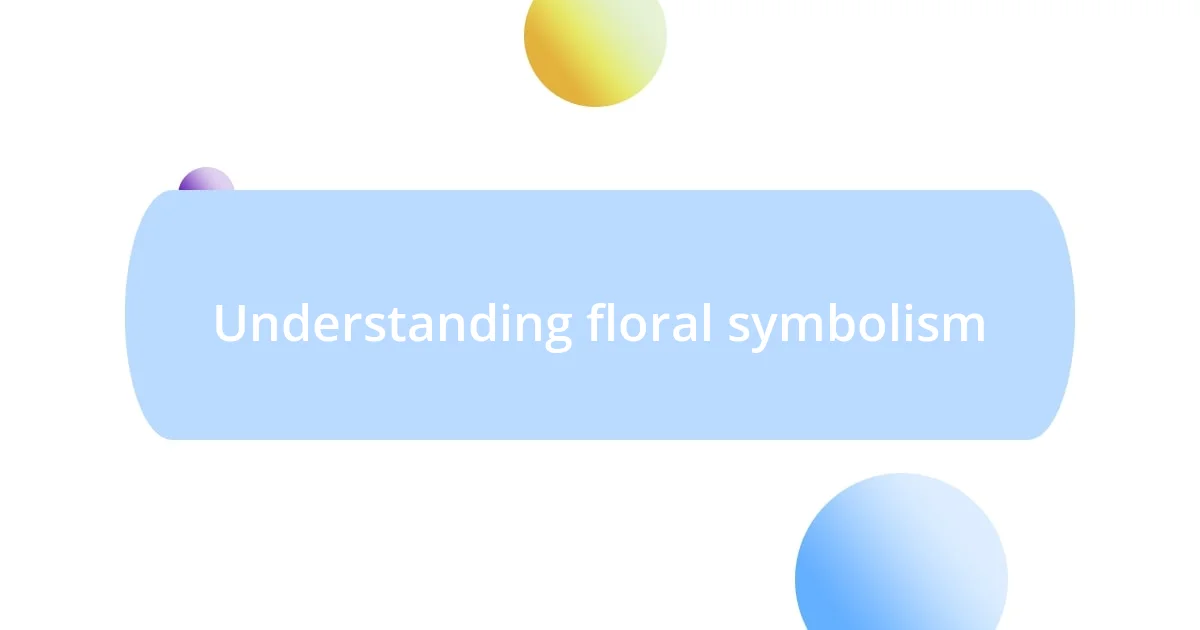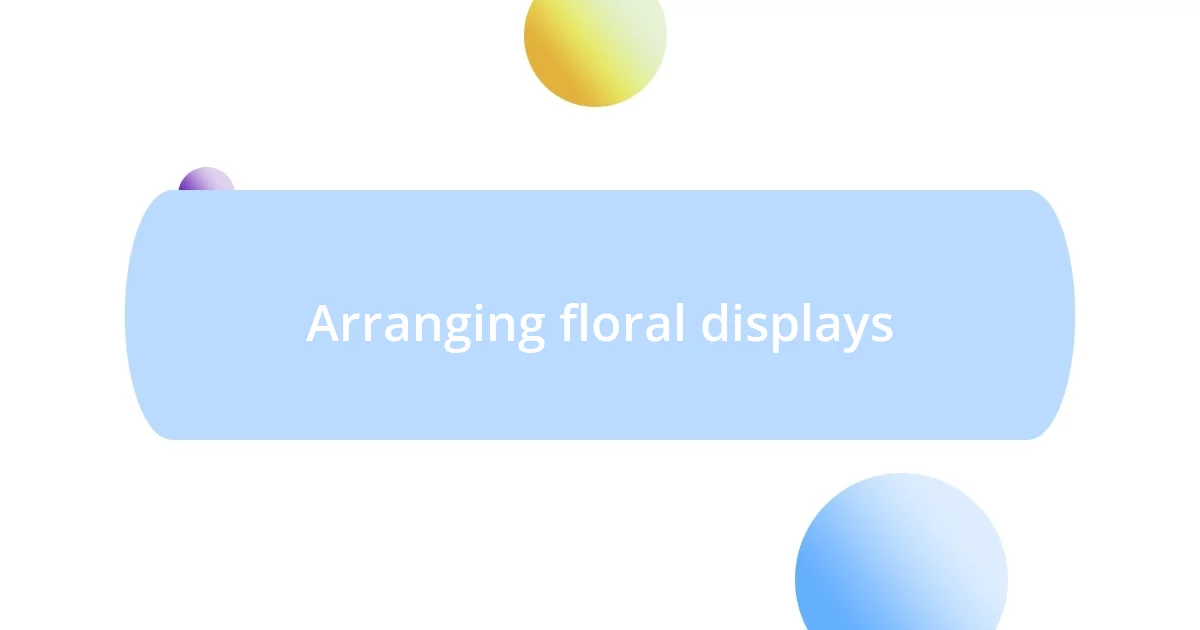Key takeaways:
- Floral symbolism in funerals evokes deep emotions, with different flowers carrying unique meanings that can reflect the individual being honored.
- Cultural variations greatly influence floral choices for memorials, with different customs interpreting flower meanings in distinct ways, such as white flowers for mourning in Asian cultures and vibrant colors in Latin American traditions to celebrate life.
- Personalizing floral tributes through favorite flowers or meaningful items can create a more heartfelt connection and reflection of the deceased, transforming the memorial into a celebration of life and shared memories.

Understanding floral symbolism
Floral symbolism in funerals is a nuanced language of its own, often evoking deep emotions that words alone cannot capture. I remember attending a friend’s service where the gentle fragrance of lilies filled the air. Each bloom spoke of purity and the hope of rebirth, reminding us that life, though fleeting, is always a journey towards something greater.
Different flowers carry distinct meanings. For instance, red roses symbolize love and respect, while chrysanthemums can represent death in certain cultures but also convey enduring love in others. Have you ever considered how the mere sight of a flower can transport you back to a specific memory or person? I find it fascinating how even a simple daisy can evoke feelings of innocence and new beginnings amidst sorrow.
Understanding these symbols not only helps us choose the right flowers but also deepens our connection to the emotions surrounding a loss. It’s as if each arrangement tells a story, capturing the essence of the departed. Personally, I’ve found that selecting flowers that reflect the individual’s personality can create a poignant memorial. How do you choose flowers for someone you’ve loved? It often boils down to what textures, colors, and scents evoke their spirit within you.

Types of flowers used
Flowers used in funerals often serve as powerful symbols of the deceased’s life and legacy. For instance, I find the use of white lilies particularly striking. They symbolize purity and innocence, and I remember when my grandmother passed away; her service was adorned with these flowers, which seemed to convey her serenity and the hope of her eternal peace. The sight of those delicate blooms created a space for reflection, drawing everyone together in shared remembrance.
On the other hand, vibrant sunflowers can evoke warmth and joy, as they symbolize adoration and loyalty. At a neighbor’s memorial, sunflowers were beautifully arranged, bringing a burst of color that illuminated the somber atmosphere. This contrast found in floral choices can profoundly affect our emotions—bright flowers can invigorate our spirits, even amidst grief, reminding us of the joy the person brought into our lives.
A comparison of common funeral flowers reveals their unique meanings and emotional connections. It’s intriguing how a single flower can carry such weight in the context of a memorial. Personally, I often find myself gravitating towards hydrangeas for their symbolism of heartfelt emotion, as they seem to represent my deep feelings of love and loss when honoring someone special.
| Flower | Symbolism |
|---|---|
| White Lilies | Purity and Innocence |
| Red Roses | Love and Respect |
| Chrysanthemums | Death and Remembrance |
| Sunflowers | Adoration and Loyalty |
| Hydrangeas | Heartfelt Emotion |

Meanings of specific flowers
Flowers possess a language all their own, particularly in a funeral setting where their meanings can evoke profound emotions. Take, for example, the striking red rose. I recall attending a service where the family surrounded the casket with these blooms. Each rose seemed to speak of love and admiration, reminding all of us of the deep connections we forged with the departed. It’s amazing how an arrangement can encapsulate years of friendship and affection in such vibrant color.
Here’s a brief look at some specific flowers and their meanings that can enrich a funeral arrangement:
- White Lilies: Symbolizing purity and innocence, often seen in memorials to evoke peace.
- Red Roses: Convey deep love and respect, a fitting tribute for those who held a special place in our hearts.
- Chrysanthemums: In some cultures, they represent death, while in others, they signify enduring love and support.
- Sunflowers: Bright and underlining joy, they symbolize adoration and loyalty and can light up a somber setting.
- Hydrangeas: These lovely blooms embody heartfelt emotion and can speak volumes about the love shared with the deceased.
The symbolism behind flowers is something I genuinely appreciate. When my friend lost her mother, we chose daisies for the service. Their delicate petals stand for innocence and new beginnings, which felt appropriate like a promise that life continues. It’s fascinating how each bloom can be a vessel for memories and emotions, creating a rich tapestry of remembrance during a time of grief.

Cultural variations in symbolism
Understanding cultural variations in floral symbolism can open our eyes to how different backgrounds interpret loss and remembrance. For instance, in many Asian cultures, white flowers are often associated with funerals as they symbolize mourning and purity. I remember attending a traditional Buddhist ceremony where the entire altar was draped in white orchids, creating an atmosphere that felt both serene and contemplative, inviting those present to reflect on life and death.
In contrast, Latin American traditions frequently embrace bright colors during funerals as a celebration of life. When my close friend’s grandmother passed away, we decorated her altar with vibrant marigolds, known as “cempasúchil.” This flower, symbolizing the fragility and beauty of life, illuminated the space, drawing everyone together in a joyful remembrance rather than solely in grief. Isn’t it interesting how the same flowers can carry different meanings, depending on cultural contexts?
Moreover, the role of flowers in African funerals can represent a connection to ancestors and honor their legacy. I recall attending a service where a family chose to incorporate a variety of flowers that were native to their heritage, creating a colorful display that celebrated the life lived. It struck me how deeply personal and significant these choices can be, serving not just as a tribute, but as a bridge connecting the living to those who have passed. When considering these diverse interpretations, I often ponder how our own experiences shape our understanding of loss and remembrance.

Choosing flowers for funerals
Choosing flowers for funerals is a deeply personal journey that reflects our feelings and memories of the deceased. I recall selecting lilies for my uncle’s service; their pure white petals just felt right. They conveyed a sense of peace I thought he would appreciate, as he had always valued serenity in life. When choosing flowers, asking yourself what emotions you wish to convey can guide you in making the perfect choice.
Another important factor to consider is the deceased’s personal preferences. Did they have a favorite flower? For me, this became a meaningful way to celebrate my grandmother. She adored forget-me-nots, so we filled the arrangement with them, symbolizing the bond we shared. That vibrant blue brought a smile to my face amidst the sorrow, reminding me of the countless summer afternoons spent together in her garden.
It’s also worthwhile to think about the practical aspects, like availability and seasonal blooms. I remember being pleasantly surprised when we found orange lilies during the service for a close family friend. Not only did they symbolize passion, but their lively color also brought a touch of joy on an otherwise heavy day. Isn’t it remarkable how these choices can transform a somber moment into a celebration of life and love?

Arranging floral displays
Arranging floral displays for funerals often requires careful thought and intention. I remember helping a friend create a tribute for her father’s memorial; we used a mix of deep reds and soft whites to symbolize love and remembrance. As we worked together, it became clear how the arrangement evolving under our hands mirrored our emotions—a beautiful way to express our grief and celebrate his life.
When it comes to the actual layout, I often think about balance and flow. A few years ago, I assembled a display that featured large, prominent blooms surrounded by smaller, delicate ones. This contrast not only drew the eye but also represented the strength and fragility of life. It made me realize how each flower, much like each individual, contributes uniquely to the overall beauty of the arrangement.
Don’t be afraid to incorporate personal elements, either. I once added small photographs of the deceased among the flowers for a family friend’s service. It felt like a gentle reminder of who he was—warm and full of stories—encapsulated within the vibrant colors around him. Have you ever considered the stories that flowers might tell? Each arrangement has the potential to unfold a narrative, making the moment all the more poignant and personal.

Personalizing floral tributes
Personalizing floral tributes can truly capture the essence of the individual we’re honoring. I recall a poignant moment when we decided to mix sunflowers and lavender for a dear friend’s service. The bright, sunny yellows of the sunflowers reflected her vibrant spirit, while the calming purple of the lavender spoke to her peaceful nature. It was a combination that not only looked beautiful but also felt like a loving reflection of who she was.
Another approach I’ve found meaningful is to include items that were significant to the deceased. For instance, during my aunt’s memorial, we adorned the floral arrangements with small charms that represented her love for music and travel. Each flower became a canvas for memories, sparking conversations among attendees about her adventures and the melodies she cherished. Have you ever thought about how personal touches might inspire shared stories? These small details create connections, allowing everyone present to celebrate the life being remembered.
Lastly, I believe that incorporating a mix of cultural or family traditions can deepen the personalization of floral tributes. At a recent gathering, we honored a friend’s heritage by including traditional flowers that held significance in her culture. It felt deeply respectful and brought a sense of unity among those who came to pay their respects. When has a floral arrangement reminded you of your roots or shared heritage? I find that such elements can transform a tribute into a heartfelt homage, binding us together in shared memories and cultural appreciation.














